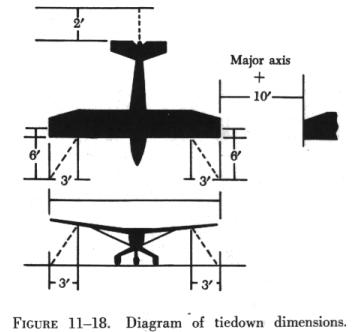AIRCRAFTTIEDOWN
AIRCRAFT TIEDOWN
| Aircraft tiedown is a very important part of aircraft ground
handling. The type of tiedown will be determined by the prevailing weather
conditions. In normal weather a limited or normal tiedown procedure is
used; but when storm conditions are anticipated, a heavy weather or storm
condition tiedown procedure should be employed.
Normal Tiedown Procedure
Small aircraft should be tied down after each flight to preclude damage
from sudden storms. The direction in which aircraft are to be parked and
tied down will be determined by prevailing or forecast wind direction.
Aircraft should be headed, as nearly as possible, into the wind, depending
on the locations of the fixed, parking area tiedown points. Spacing of
tiedowns should allow for ample wingtip clearance (figure 11-18). After
the aircraft is properly located, lock the nosewheel or the tailwheel in
the fore and aft position. |
|
Tiedown Anchors
All aircraft parking areas should be equipped for three point tiedowns.
This is facilitated at most airports by use of tiedown anchors installed
in concrete parking areas. Tiedown anchors, sometimes called "pad eyes,"
are ringlike fittings installed when the parking area is poured. They are
normally set flush with the surface of the concrete or no more than one
inch above it. There are several types of tiedown anchors in use. The type
selected is usually determined by the material used in aircraft parking
areas, since it may be a concrete paved surface, a bituminous paved surface,
or an unpaved turf area.
Location of tiedowns is usually indicated by some means such as white
or yellow paint markings or by surrounding the tiedown anchor with crushed
stone.
Tiedown anchors for small single engine aircraft should provide a minimum
holding power (strength) of approximately 3,000 pounds each. Although this
minimum can be achieved when stake driven tiedowns are used in dry or turfed
areas, such stakes will almost invariably pull out when the ground becomes
soaked from torrential rains which accompany hurricanes and some thunderstorms.
Tiedown Ropes
Tiedown ropes capable of resisting a pull of approximately 3,000 pounds
should be used to secure light aircraft. Cable or chain tiedown is usually
preferred for tying down large aircraft.
Manila ropes should be inspected periodically for mildew and rot. Nylon
or Dacron tiedown ropes are preferable to manila rope. The objection to
manila rope is that it shrinks when wet, is subject to mildew or rot, and
has considerably less tensile strength than either nylon or Dacron. Various
types of commonly used tiedown rope are compared in figure 11-19.

Tiedown Cable
Tiedown cables are often used to secure aircraft, especially in the
case of large aircraft. Most cable-type tiedowns are accomplished with
some form of tiedown reel designed for rapid and reliable securing of all
types of aircraft. figure 11-20 illustrates the
operation of a typical cable tiedown reel.
In A of figure 11-20 the cable is released by
depressing the release lever to provide cable slack. One end of the cable
is then attached to the aircraft tiedown ring and the other end to a tiedown
anchor. The starwheel on the reel (B of figure 11-20)
is then turned clockwise to remove excess slack from the cable. The locking
handle is then secured to the bar when the cable has been adjusted for
the desired tautness (C of figure 11-20). Finally,
as shown in D of figure 11-20, the locking cam
is secured to complete the tiedown procedure.
Tiedown Chains
The chain-type tiedown sometimes is used as a better and stronger tiedown
to secure the heaviest aircraft. This tiedown assembly is composed of an
all metal quick release mechanism, a tensioning device, and a length of
chain with hooks (figure 11-21).

